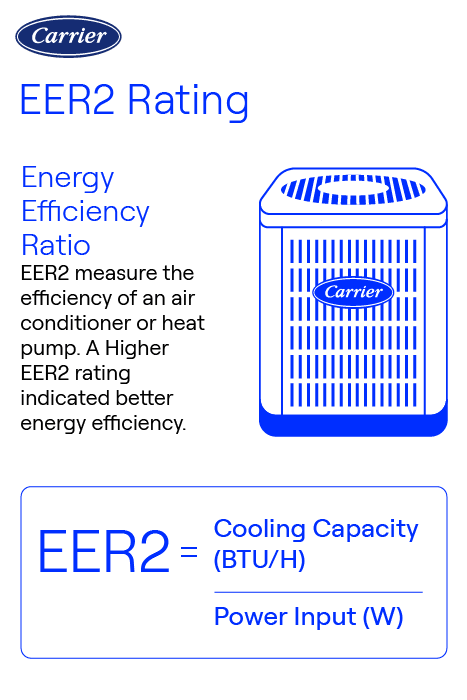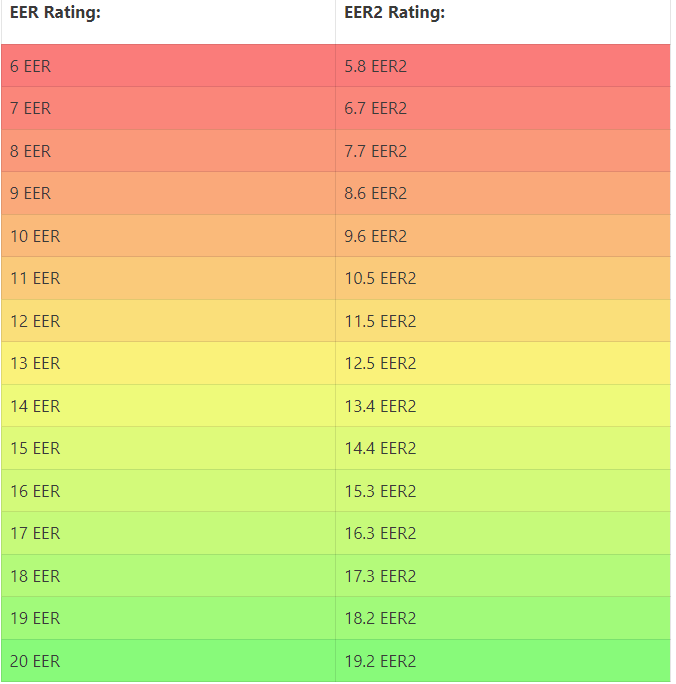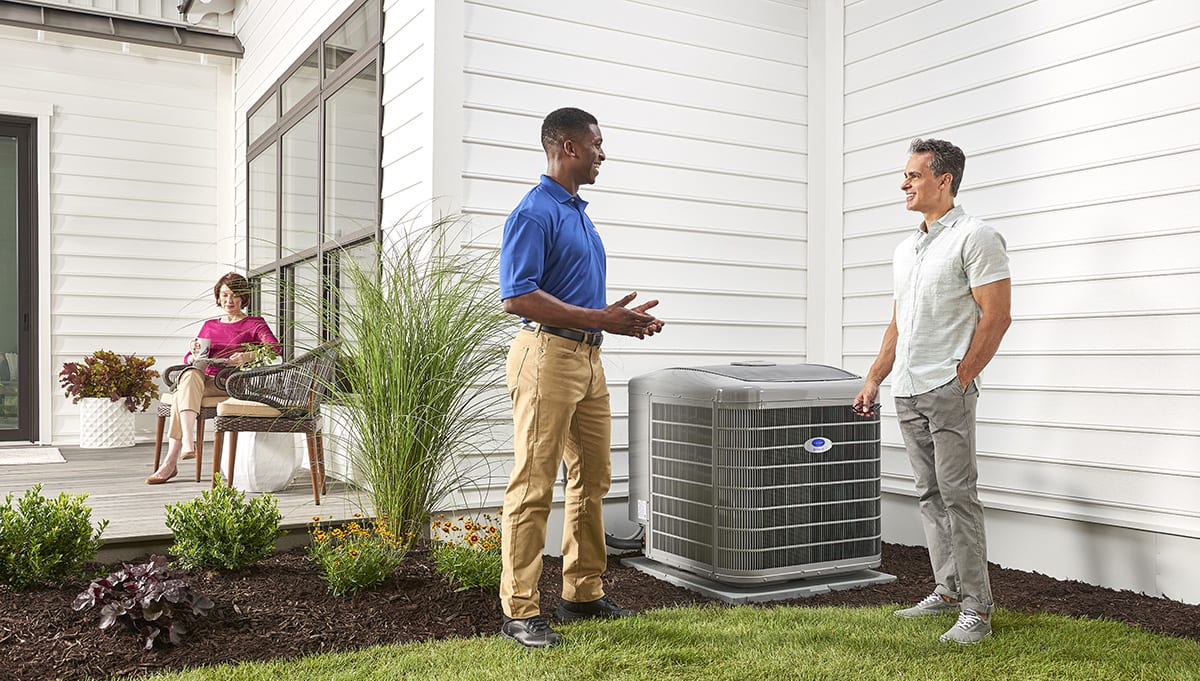EER Meaning: Your Guide To Energy Efficiency Ratio 2 (EER2)
EER Meaning: What is Energy Efficiency Ratio (EER2)?
The Energy Efficiency Ratio (EER2) is a metric used to measure the energy efficiency of air conditioning systems. It offers a standardized way to compare the cooling output of different air conditioners relative to the amount of electrical energy they consume.
EER2 (Energy Efficiency Ratio 2) is a new metric introduced to provide a more accurate measure of energy efficiency for air conditioning systems, considering updated testing conditions that better reflect real-world usage. EER2 is calculated similarly to the traditional EER but under revised testing conditions that account for higher external static pressures, providing a more realistic measure of efficiency.

Calculate Energy Efficiency Ratio, or EER
EER2 is calculated by dividing the cooling capacity of an air conditioner in British Thermal Units (BTUs) per hour by the power consumption in watts. EER2 uses a different test method than EER, using higher static pressure (i.e. more input power), so EER2 values are lower than EER. The below chart shows EER TO EER2 conversions. The higher the EER2 rating, the more efficient the air conditioner is in converting electrical energy into cooling power.

EER2 is a vital factor to consider when purchasing an air conditioner because it directly affects energy consumption and operating costs. Higher EER2 ratings indicate that the air conditioner is more energy-efficient and will consume less electricity to provide the same cooling output.
Benefits of High Energy Efficiency Ratio, or EER2
When selecting the perfect cooling system for your home, it's important to consider the energy efficiency ratio (EER2). The EER2 measures the cooling capacity of an air conditioner or heat pump against the amount of energy it consumes. Opting for a system with a high energy efficiency ratio offers several advantages:
- Lower energy consumption and cost savings: A high EER2 means that your cooling system can provide the same level of cooling with less energy usage. This translates to lower energy bills and significant cost savings over time. With Carrier's range of energy-efficient cooling solutions, you can stay comfortable without breaking the bank.
- Reduced environmental impact: By choosing a cooling system with a high energy efficiency ratio, you are actively contributing to a greener environment. These systems consume less energy, reducing the demand for fossil fuels and lowering greenhouse gas emissions. Carrier is committed to sustainability and offers a wide range of energy-efficient products that help minimize your carbon footprint.
- Improved cooling performance and comfort: A high EER indicates that a cooling system can effectively remove heat from your home, resulting in improved cooling performance and enhanced comfort. With Carrier's high-performance AC systems , you can enjoy a more consistent and comfortable indoor environment, even during the hottest months of the year.
Factors Affecting EER2, or Energy Efficiency Ratio
When it comes to maximizing energy efficiency in your home, several factors can impact the Energy Efficiency Ratio (EER) of your HVAC system. Understanding these factors can help you make informed decisions to optimize your home's energy consumption. Let's explore the key factors that affect the EER:
- Equipment Size and Capacity: Choosing the right size and capacity of your HVAC system is crucial for achieving optimal energy efficiency. Undersized systems may struggle to cool or heat your home efficiently, while oversized systems can result in short-cycling and energy wastage. Consult with your local Carrier dealer to ensure your system is properly sized for your home's needs.
- Insulation and Sealing: Proper insulation and sealing play a vital role in maintaining energy efficiency. Well-insulated homes retain conditioned air, reducing the workload on your HVAC system. Additionally, sealing air leaks in windows, doors, and ductwork prevents energy loss, allowing your system to operate more efficiently.
- Maintenance and Regular Servicing: Regular maintenance and servicing are essential for preserving your HVAC system's energy efficiency. Dirty air filters, clogged coils, and worn-out components can hinder your system's performance and increase energy consumption. Schedule annual AC maintenance and address any issues promptly to keep your system operating optimally.
By considering these factors and implementing appropriate measures, you can enhance the energy efficiency of your HVAC system, resulting in lower energy bills and a reduced environmental footprint.

How to Improve Energy Efficiency Ratio (EER)
If you're looking to enhance the energy efficiency of your air conditioner, there are several steps you can take to improve its Energy Efficiency Ratio (EER). By optimizing your cooling system, you can not only reduce your carbon footprint but also save on energy costs in the long run. Here are some tips to help you achieve a higher EER:
- Upgrading to a higher efficiency air conditioner: Consider replacing your old unit with a newer model that has a higher EER rating. Look for air conditioners that are ENERGY STAR® certified, as they meet strict energy efficiency guidelines set by the U.S. Environmental Protection Agency.
- Proper installation and sizing: Ensure that your air conditioner is installed correctly and sized appropriately for your home. Improper installation or an oversized unit can lead to energy wastage and reduced efficiency.
- Tips for optimizing energy efficiency: Implement these simple practices to maximize your air conditioner's energy efficiency:
- Regularly clean or replace air filters to improve airflow
- Keep doors and windows closed to prevent cool air from escaping.
- Use ceiling fans to enhance air circulation and reduce the workload on your air conditioner.
- Set your thermostat to a higher temperature when you're away to conserve energy.
- Seal any air leaks in your home to prevent cool air from seeping out.
How to Choose the Right Carrier Product Based on EER2
Climate
If you live in a hot and dry climate, a high EER2-rated unit is ideal, as EER2 measures efficiency at peak temperatures.Energy Savings vs. Upfront Cost
Units with a higher EER2 are more efficient but may have a higher initial price. However, they may reduce cooling bills over time.Size and Cooling Needs
Ensure the unit is properly sized for your home. An oversized or undersized unit can lead to inefficiencies despite a high EER2 rating.Carrier Model Options
Carrier offers high-EER2 models, specifically the Infinity® Series, which provide optimal efficiency and comfort. For the best choice, consult a Carrier dealer, who can recommend the right unit based on your home’s cooling requirements and energy efficiency goals.Work With A Carrier Dealer To Select a High EER2 AC For Your Home
Carrier offers a range of energy-efficient air conditioners that are designed to provide optimal cooling while minimizing energy consumption. With advanced technologies and innovative features, Carrier's AC models are built to deliver exceptional energy efficiency, making them an excellent choice for homeowners who prioritize sustainability and cost savings. Schedule an appointment with your local Carrier professional to determine the right HVAC system for your home.

Frequently Asked Questions About EER Meaning
To calculate the Energy Efficiency Ratio (EER), divide the cooling capacity of the air conditioning system (in British Thermal Units or BTUs) by its power consumption (in watts). The formula is:
EER= Power Consumption (Watts) / Cooling Capacity (BTUs)
A higher EER indicates a more efficient system. For example, if an AC unit provides 12,000 BTUs of cooling and consumes 1,200 watts, its EER is 10.
